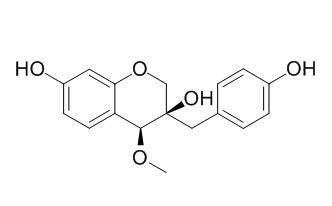3'-Deoxy-4-O-methylsappanol
3'-Deoxy-4-O-methylsappanol shows moderate cytotoxicities against cultured human melanoma HMV-II cells with the IC50 value of 872.0 uM ± 2.4.
Inquire / Order:
manager@chemfaces.com
Technical Inquiries:
service@chemfaces.com
Tel:
+86-27-84237783
Fax:
+86-27-84254680
Address:
1 Building, No. 83, CheCheng Rd., Wuhan Economic and Technological Development Zone, Wuhan, Hubei 430056, PRC
Providing storage is as stated on the product vial and the vial is kept tightly sealed, the product can be stored for up to
24 months(2-8C).
Wherever possible, you should prepare and use solutions on the same day. However, if you need to make up stock solutions in advance, we recommend that you store the solution as aliquots in tightly sealed vials at -20C. Generally, these will be useable for up to two weeks. Before use, and prior to opening the vial we recommend that you allow your product to equilibrate to room temperature for at least 1 hour.
Need more advice on solubility, usage and handling? Please email to: service@chemfaces.com
The packaging of the product may have turned upside down during transportation, resulting in the natural compounds adhering to the neck or cap of the vial. take the vial out of its packaging and gently shake to let the compounds fall to the bottom of the vial. for liquid products, centrifuge at 200-500 RPM to gather the liquid at the bottom of the vial. try to avoid loss or contamination during handling.
J Agric Food Chem.2018, 66(1):351-358
Sci Rep.2021, 11(1):21038.
J Agric Food Chem.2015, 63(44):9869-78
J Korean Med Ophthalmol Otolaryngol Dermatol2023, 36(1):1-20.
Sci Rep.2017, 7:467-479
The Korea Journal of Herbology2019, 34(2):25-32
Plos One.2019, 15(2):e0220084
J Plant Biotechnol.2023, 50:070-075.
Appl. Sci.2021, 11(24),12080
Phytochem Anal.2016, 27(5):296-303
Related and Featured Products
Planta Med. 2013 Jan;79(1):37-44.
Suppression of melanin synthesis by the phenolic constituents of sappanwood (Caesalpinia sappan).[Pubmed:
23154842]
Sappanwood (Caesalpinia sappan Linn.) is used as an herbal medicine. It is sometimes used to treat skin damage or as a facial cleanser.
METHODS AND RESULTS:
In the present study, the methanol (MeOH) extract of sappanwood was found to inhibit melanin synthesis in cultured human melanoma HMV-II cells stimulated with forskolin, and six active compounds (1-5 and 7) were isolated from the extract along with a non-active compound (6). Compounds 2-7 were identified as sappanchalcone (2), 3'-Deoxy-4-O-methylsappanol (3), brazilein, (4), brazilin (5), sappanol (6), and 4-O-methylsappanol (7). Compound 1 was a new compound, and its structure was determined to be (6aS,11bR)-7,11b-dihydro-6H-indeno[2,1-c]chromene-3,6a,10,11-tetrol by spectroscopic analyses. Among the six active compounds, brazilin (5) (EC50: 3.0 ± 0.5 µM) and 4-O-methylsappanol (7) (EC50: 4.6 ± 0.7 µM) strongly suppressed melanin synthesis in HMV-II cells. Bioactive compounds showed moderate cytotoxicities against HMV-II cells with IC50 values of 83.1 ± 4.0 µM (for 2), 72.0 µM ± 2.4 (for 3), 33.8 ± 1.1 µM (for 4), 18.4 ± 0.8 µM (for 5), and 20.2 ± 0.8 (for 7), respectively. Brazilin (5) selectively suppressed the expression of mRNAs for tyrosinase-related protein (TYRP) 2 and tyrosinase but did not influence the expression of TYRP1.
CONCLUSIONS:
These results suggest that brazilin (5) is a new class of melanin inhibitor and that sappanwood could be used as a cosmetic material.



